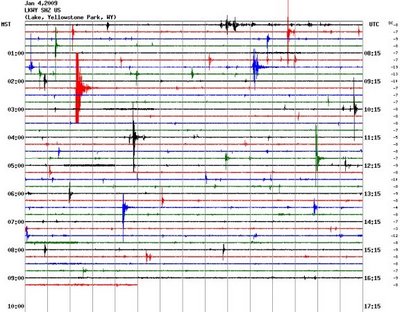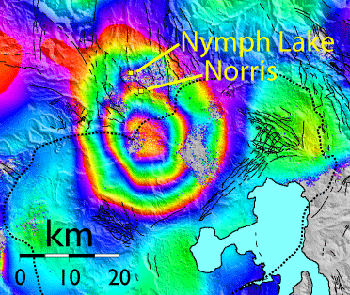Sunday, January 04, 2009
Quake swarm in Yellowstone
UPDATE (5Jan09): The quake storm may be quieting down. Here's a seismograph from yesterday, from the Volcanism Blog [link to story], which notes, " If volcanic catastrophe were imminent you would be able to see the face of God in [these] data."

Original story:
 The local (Cody WY) newspaper says that there's "no indication the park’s famous caldera is likely to erupt." But in Honolulu, where the reporters know something about volcanos, the paper tells a different story under the headline, Quake swarm at Yellowstone may signal blast.
The local (Cody WY) newspaper says that there's "no indication the park’s famous caldera is likely to erupt." But in Honolulu, where the reporters know something about volcanos, the paper tells a different story under the headline, Quake swarm at Yellowstone may signal blast.
The Honolulu Star Bulletin goes on
Meanwhile, the local Wyoming paper quotes a Yellowstone Park employee saying, "We're not packing."
Hmm. Probably nothing.
[source for picture above]

Original story:
 The local (Cody WY) newspaper says that there's "no indication the park’s famous caldera is likely to erupt." But in Honolulu, where the reporters know something about volcanos, the paper tells a different story under the headline, Quake swarm at Yellowstone may signal blast.
The local (Cody WY) newspaper says that there's "no indication the park’s famous caldera is likely to erupt." But in Honolulu, where the reporters know something about volcanos, the paper tells a different story under the headline, Quake swarm at Yellowstone may signal blast.The Honolulu Star Bulletin goes on
More than 250 small earthquakes occurred in Yellowstone Park between Dec. 26 and Monday.[snip]
Scientists wonder if last month's swarm of tremors, the most numerous and intense in this area in many years, might be a harbinger of a larger event.
Yellowstone National Park sits atop a supervolcano. The entire park is the depression of a caldera more than twice the size of Oahu that is the result of an unimaginably large eruption some 600,000 years ago.
By comparison, the caldera left by the explosion of Mount Saint Helens in 1980 is about the size of downtown Honolulu.
Saint Helens ejected 1.4 billion cubic years of ash that was detectable over an area of 22,000 square miles.
The last Yellowstone eruption, which was not even the largest in Yellowstone's history, ejected 2,500 times the ash of the Saint Helens explosion.
Should we be alarmed by this uptick in activity?
Scientists studying Yellowstone from the U.S. Geological Survey, University of Utah and National Park Service at the Yellowstone Volcano Observatory say that recurrences of cataclysmic eruptions are not regular or predictable.
A supervolcano eruption at sometime in the future is inevitable with 100 percent probability. Eight supervolcano eruptions are known from the geologic record and there may be even more.
Although nothing, including the recent earthquake swarm, points conclusively to an imminent eruption, the researchers note that Yellowstone erupts about every 600,000 years.
Geologists continuously monitor the inflation and deflation of the Yellowstone Plateau, which indicates pressure changes in the magma chamber that lies as close as 5 miles below the surface in some places.
The elevation of the caldera is 35 inches higher than when measurement began in 1923, and it has been moving upward since mid-2004 at a rate of up to three inches a year - more than three times faster than has ever been measured previously.
Meanwhile, the local Wyoming paper quotes a Yellowstone Park employee saying, "We're not packing."
Hmm. Probably nothing.
[source for picture above]
Technorati Tags: Environment, ScenarioPlanning
Comments:
Post a Comment




